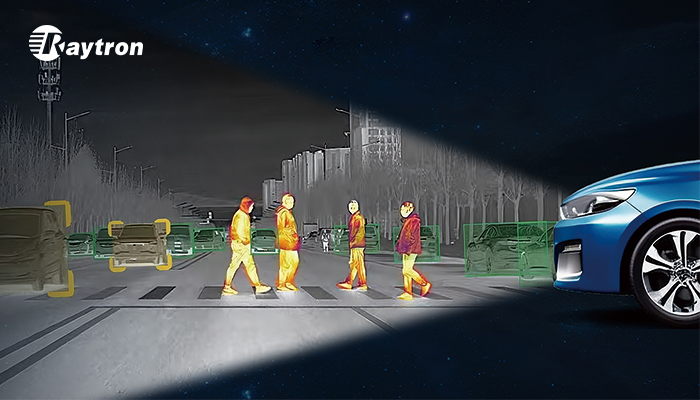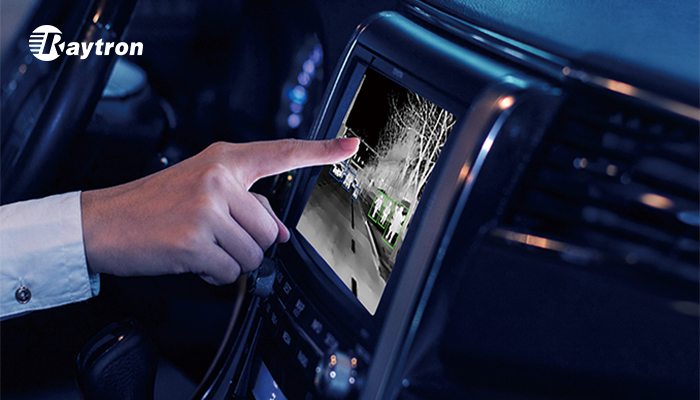How dangerous is nighttime driving? NHTSA data reveals that the passenger vehicle occupant fatality rate at nighttime is about three times higher than the daytime rate. Glare, high beams, the black hole effect (sudden lose of visibility), and haze compromise ADAS performance. However, Raytron’s automotive thermal cameras cut through these threats by detecting heat signatures from pedestrians, animals and objects. Integrated into Zeekr’s G-Pilot H9 sysem, Raytron’s thermal imaging sensors provide critical obstacle recognition on pitch-dark rural lanes or amid ongoing glare.
Thermal Imaging vs. Conventional ADAS Sensors
Traditional sensors each have drawbacks. LiRAR remains cost-prohibitive for mass-market vehicles, millimeter-wave radar delivers poor spatial resolution, and visible cameras falter in poor visibility. By contrast, thermal imagers offer robust, all-weather ADAS performance with unique advantages:
lAll‑weather Vision: Unaffected by darkness, glare, haze or dust, thermal cameras accurately detect pedestrians, animals and other obstacles up to 300 m away.
lSafer Passive Imaging: Zero active emissions means no electromagnetic interference with other sensors, ideal for sensor fusion platforms (e.g., Zeekr 9X’s five LiDAR sensors).
lGlobal Compliance “Passport”: With the 2025 Euro NCAP mandating adverse‑weather tests and the 2027 C‑NCAP adding nighttime assessments, thermal cameras have become automakers’ key to international compliance.

Which Top Automakers Collaborate with Raytron?
Raytron’s innovation in thermal imaging technology has garnered significant attention from top automotive OEMs, leading to strategic partnerships aimed at enhancing driving safety:
lZeekr: The newly launched Zeekr 9X features co-developed infrared cameras, delivering all-terrain, all-weather safety redundancy.
lBYD: Premium models including Yangwang U8 and Fangchengbao Bao 8 standardize Raytron’s night vision camera to ensure reliable perception in extreme off-road environments.
lGeely Goup: As a Tier-1 supplier, Raytron’s thermal sensors are integrated across Geely’s portfolio, boosting safety.
lDayun Auto: In 2023, Dayun delivered two series-production vehicles equipped with our thermal imagers.
lDidi Autonomous Driving: Raytron’s automotive thermal imaging cameras provide around-the-clock perception for Robotaxi and its commercial vehicles.
Additional partners include Great Wall Motor (GWM). From luxury flagships to volume models, Raytron’s end-to-end vertical integration transforms thermal imaging from a “luxury option” to an “essential safety standard”.

What Are the Key Advantages of Raytron’s Thermal Imaging Solution?
lPioneering Detector Chips: Launched the world’s first 6μm 1920×1080 uncooled infrared detector and developed AEC-Q100 certified infrared MEMS chip and ISP chip for automotive use.
lComplete Value-Chain Integration: Vertically integrated chip-module-system enables rapid, scalable delivery across premium and mid-range vehicles.
lProprietary AI Algorithms: Our shutter-free algorithm prevents data loss from shutter freeze, while the AI-driven “Matrix IV Super-Resolution” enhances thermal details from 640×512 to near 1920×1080 detail.

The Future of Nighttime Road Safety
The adoption of Raytron’s thermal cameras in the Zeekr 9X underscores a broader trend: thermal imaging will join LiDAR and millimeter-wave radar as a core component of next-generation ADAS systems. As global regulations tighten and demand for night vision safety grows, Raytron remains at the forefront, advancing thermal imaging technology, revolutionizing nighttime driving safety, and expanding the frontiers of human perception.